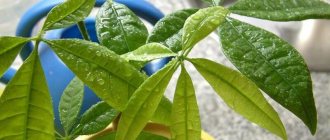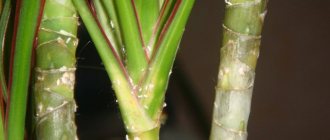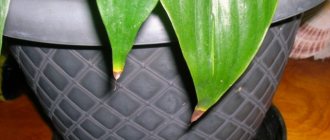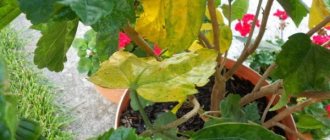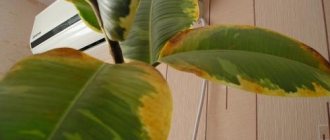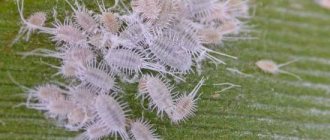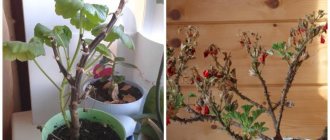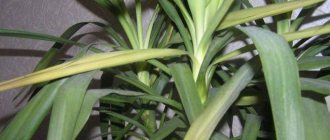Aloe is a frequent visitor to city apartments. This is not surprising, because agave belongs to that rare category of plants that are very difficult to destroy. However, sometimes “force majeure” situations happen to him.
We are accustomed to considering aloe as a crop that is almost impossible to harm. And yet, sometimes even such an unpretentious plant can fall ill. Yellowing of leaves is perhaps the most common problem faced by gardeners who grow agave on their windowsill.
In our area, aloe vera is most often grown - a branched multi-stemmed succulent with narrow jagged leaves. At the same time, in the West, aloe vera, a close relative of the well-known agave, is more popular.
These plants differ in their structure. Aloe vera has leaves that grow directly from the root, while tree aloe has leaves attached to the stem. In addition, the leaf blades of aloe vera are much wider and fleshier, and the serrations on them are slightly smaller. However, these plants are cared for almost the same way.
Let's look at the most common reasons why leaves of different types of aloe may begin to turn yellow.
Excess light
Aloe is very undemanding when it comes to location, but that doesn't mean you don't need to consider its lighting needs. Despite the fact that in nature these plants live in deserts under the scorching rays of the sun, at home in extreme heat they will require shading.
For most of the year, in our area the sun is not as active as in the historical homeland of the agave. And since the plant has managed to adapt to precisely this “gentle” insolation regime, direct sunlight can be destructive for it.
It is especially important to monitor the plant from October to March. At this time, all biological processes that occur in aloe slow down significantly. A hibernating plant will not be able to cope with the active winter sun, so the plant may need additional shading.
Causes
The causes of diseases and deterioration in the condition of the flower may be improper maintenance conditions. The culture belongs to succulents, that is, in nature this plant develops in a hot climate in sandy light soils. And therefore, a common mistake gardeners make that leads to rot is excessive watering.
With abundant watering, the soil spreads out, and after drying, the soil sets and becomes hard. Due to its peculiarity, this plant breathes not only the above-ground part, but also the underground part, that is, carbon dioxide continuously enters the soil. All these processes form acidification of the soil, nutrients are transformed into forms that aloe cannot absorb. Together, waterlogging and acidity of the soil lead to the occurrence of root diseases.
Another cause of rotting processes can be a cramped container in which the agave is planted. An adult specimen weaves its roots into a tight ring. Frequent watering provokes dampness inside the earthen clod, and oxygen is not supplied.
The florist visually notices only the dried surface of the soil and continues to moisten the plant. Due to such stress, the aloe begins to rot.
The situation gets even worse when hypothermia is added to the overflow. This problem most often occurs in winter and autumn. At this time, cold air blows through the window slits, and the soil quickly freezes. The same consequences are possible due to watering the agave with cold water.
Pathogenic bacteria can develop due to improper feeding. For example, many gardeners try to feed a fading specimen with fertilizers.
A sick plant cannot be fertilized; this only enhances the development of harmful microorganisms. Manure and bird droppings have especially negative consequences for aloe.
Temperature violation
The optimal air temperature for tree aloe, regardless of the time of year, is 23-25°C, while the plant can feel great even at lower temperatures. However, there is a condition - the air temperature must decrease gradually.
A sharp cold snap with a temperature drop of 10°C will definitely make itself felt. However, prolonged exposure to direct sunlight in hot weather (above 29°C) will also manifest itself.
Most often, agave plants, which are placed on a glassed-in loggia or balcony during the spring and summer, suffer from sudden changes in temperature. Therefore, it is very important to monitor weather forecasts and, depending on the situation, shade or take the plant indoors.
Yellowness at the base
The appearance of yellowness at the base of the agave indicates an excess of water at the roots. This negative factor leads to the appearance of root rot, which progresses once it reaches the base of the flower.
What to do?
To save aloe from death, you need to do a few simple manipulations:
- Remove the flower from the pot, clean it from the soil and remove all rotten parts of the rhizome.
- Use a knife to remove diseased areas from the stem: cut until healthy “flesh” appears.
- Rinse all cut areas with water, dry well, and then treat with ground coal.
- The aloe should lie down for 2-3 hours, after which it is transplanted into a small flowerpot.
It is necessary to water rarely and only with the help of a tray until the agave takes root.
Wrong substrate
Like the vast majority of succulents, aloe prefers light and loose soil, preferably with weak acidity, although the plant will like neutral values.
Substrate for aloe: 2 parts leaf soil, 1 part baking powder (perlite, vermiculite, river sand), 1 part humus. The soil is laid in layers - at the bottom there is a 2-3 cm layer of drainage, followed by a substrate, and on top of the “trunk circle” of aloe is mulched with sand, fine gravel, perlite or vermiculite.
Failure to adhere to the watering schedule
The leaves of a plant can turn yellow either from a lack or from an excess of water. But how can you tell whether a plant needs more or less fluid?
The easiest way to check if a plant has enough water is to “test” the soil with a wooden stick. If the soil is dry, “water” the aloe, but do it without fanaticism - the plant needs a little time to recover.
If you are unable to determine the degree of moisture in the substrate using available means, take a close look at the leaves of the plants. In “under-watered” aloe, they are noticeably thinner and yellower than in healthy plants, while in over-watered ones the leaves are more brownish than yellow. Turgor can remain quite elastic.
What to do to prevent pests?
Preventing diseases and pests is much easier than fighting them and their consequences. To protect plants, you just need to carefully observe them, noting all changes. And also take precautions when replanting or the appearance of new “neighbors” on the windowsill. Replant, fertilize and process in a timely manner. Water on time and do not disturb the temperature regime.
It is worth adhering to these requirements when caring for the plant:
- When using old pots when replanting, gardeners should not forget to treat them with disinfectant compounds.
- When rooting new cuttings, be sure to choose a larger container. So that the roots have enough room to grow.
- The soil taken from the garden plot should be heated in the oven or poured with boiling water to destroy pests.
- Wipe the aloe leaves and inspect the trunk weekly. Thanks to this, you can not only notice warning signs in time, but also prevent the appearance of diseases and pests.
A strong, healthy plant can easily withstand both stress factors and various diseases. And flower growers can keep their pets healthy only by carefully caring for the greenery in their home. With proper care, monitoring the condition of the soil, and timely elimination of violations in technology, both aloe and other flowers will delight you all year round.
Lack of space
Once the aloe has settled down well after being transplanted into a new pot, it immediately begins to produce numerous side shoots. At some point, the plant’s stems no longer have enough space outside the pot, and its roots become cramped inside. The aloe root system fills all the free space, which is why the agave begins to experience a shortage of water and nutrients and gradually dries out. However, some shoots may look quite healthy.
Cut out “extra” side shoots in a timely manner, regularly divide and replant the agave into larger containers.
Why do aloe leaves turn yellow and leaf tips dry out?
There are many reasons that cause yellowing and drying of aloe leaves. All of them are associated with violation of growing conditions. As a result, the natural immunity of the plant is reduced.
There are more than 500 types of aloe
Main provoking factors:
- insufficient lighting;
- temperature inconsistency;
- long absence of transplantation;
- pot too big;
- drying out roots;
- pests, diseases;
- using cold water for irrigation;
- lack of nutrients;
- non-compliance with the watering regime.
Problems with leaves can occur in aloe even with a slight violation of the conditions. This is how the plant shows that it needs help. And the sooner the root cause is eliminated, the faster the succulent will recover.
How to save a flower if it dies
Most often, aloe leaves begin to wither due to dysfunction of the root system. This can be caused by a cramped pot, overwatering or drying out. Regardless of the main reason, the plant can only be saved by replanting.
In this case, the damaged roots and leaves are removed and the substrate is completely replaced. The new soil should not only be nutritious, but also contain sand, which will eliminate the possibility of moisture stagnation.
It is important to know! You can water the succulent for the first time after replanting no earlier than a month later.
Disease
Densified plantings, non-compliance with the watering schedule and constant stress lead to the fact that rot begins to develop on the plant.
Dry rot develops very quickly and almost always leads to the death of the plant. First, the tips of medium-sized, fairly developed leaves dry out. Then the disease spreads to the central part of the leaf blade. The dead leaf dries out and curls, and the rot spreads to the adjacent stem.
Aloe dies from the inside, so you can save the plant only if you immediately separate healthy cuttings from the agave for further rooting. Even if you divide the plant, remove the affected trunks, and transplant the healthy parts of the plant into a new substrate, having previously treated the roots with a biofungicide, for example, Alirin or Glyocladin, this will not give a 100% guarantee.
With root rot, aloe leaves become thinner and more watery, quickly wither and fall off. The color of the leaf blades changes from green to yellow. The stems become fragile and break off easily, and an unpleasant odor emanates from the plant. If you suspect root rot in your aloe, remove the centenarians from the pot and carefully inspect the roots. Cut out the affected parts of the plant, separate the healthy parts and replant (if a healthy part of the root remains) or root.
- Aloe: how to grow and use
The beneficial properties of aloe have been known for more than three thousand years. Find out how to grow and use it at home.
How to revive a completely dried out plant
Flower growers often ask: if aloe dries out, how to replant and restore the plant? This issue needs to be looked into.
If there is no watering for a long time, the root system stops functioning, and therefore stops feeding the leaves. Abundant watering in this case will only speed up the death of the succulent.
You can save the flower by rooting the top. To do this, cut it with a clean knife and dry the cut for 1-2 hours. After this, sprinkle with any root-forming agent and plant in a mixture of peat and sand in a 1:1 ratio.
Important! During the rooting period, aloe is watered once every 3 weeks and through a tray so that only the bottom layer of soil is moistened.
Incorrect organization of fertilizing
It’s not enough to just buy the “right” fertilizer for the plant; you also need to know how to apply fertilizer without harming the plant. A few simple rules:
Never feed a plant while it is sick. Do not rush to feed new and recently transplanted plants. In the latter case, it will be much more beneficial for aloe if you treat the roots with a growth stimulator (Kornevin, Heteroauxin) before planting. Make sure that the fertilizer does not get on the trunk or leaf blades of the plant. Fertilize in cloudy weather (to avoid burns if the solution gets on parts of the plant). It is advisable to start in the morning so that by night the top layer of soil has time to dry out at least a little.
If you notice yellow, orange or reddish spots on the leaves of aloe, remember the last time you fed not only the agave, but also other inhabitants of the windowsill. Perhaps, in the process of foliar feeding a neighboring plant, you accidentally got droplets of fertilizer on the aloe, which is why burns appeared on it.
For many people, agave is not only an unpretentious houseplant, but also a valuable raw material for the preparation of growth stimulants or agents for the treatment of various diseases, for example, peeled agave leaf blades can be used to relieve sore throats with sore throat or pharyngitis.
Pests
Pests that constantly attack flowers become a real disaster for lovers of indoor plants. Because they can not only damage, but also destroy green areas.
Spider mite
Yellowing leaves and a thin web of light webs are a symptom that the plants have been attacked by the most common pest - spider mites. With such a tiny size - about 1 mm, the insect does a lot of harm. Having settled in a colony on the underside of young leaves, the mite sucks out the tender juice, depleting the plant.
If the yellow turns to red and then the leaf dies, you should act immediately:
- move the plant away from others, isolating and preventing infection;
- treat the flower with acaricides - preparations intended to control pests;
- Repeat treatment of all leaves twice with an interval of 5 days.
Important! It is advisable to do this on the balcony, on the street or, in extreme cases, in the bathroom late in the evening, then tightly closing the door. Because the products are not only harmful to humans, but also have a strong, unpleasant odor.
In addition to long-used effective drugs, folk recipes are also used. For example, shavings of laundry soap are diluted in a decoction of onion peels and the plant is treated, carefully wiping each leaf with a sponge.
The influence of scale insects and false scale insects
Scale looks like a small plaque on the trunk or leaf of a plant. It also settles in a colony and sucks out the juice, depriving the flower of the forces so necessary for growth and development. Leaves in damaged areas dry out. With severe lesions they turn yellow, and then dark reddish, later brown spots appear on them. After which the leaf dies.
The false scale insect is very similar in appearance to the scale insect. It inhibits photosynthesis by feeding on juice and pulp, and also deprives the plant of its ability to grow. The pest injects a toxic substance into the spaces formed in the places of its “activity”. Which quickly leads to the death of the flower.
The plant should be immediately isolated from the rest. Carefully treat the place where it stood and the plant itself with special preparations or garlic tincture. Some use alcohol solutions to save aloe and other flowers from this pest, also wiping all the leaves and trunk.
Mealybug
Noticing that the tips of the aloe leaves began to turn yellow, and the trunk suddenly seemed to be covered with pieces of wax, flower growers understand that the reason is a mealybug. The places covered by this pest begin to rot, deprived of oxygen.
Attention! The scale insect does not like moisture. Therefore, to combat it, sometimes it is enough to treat the plant with special compounds containing alcohol or a small amount of apple cider vinegar. They must be used carefully so as not to burn the aloe.
After carefully wiping every centimeter of the succulent, you need to move it to semi-darkness for several days. This will increase your chances of getting rid of the mealybug. Within 10 days, repeat the treatment 3 more times, using regular wet wipes.

